Over the years many have believed that Silverstone is not the ideal motor racing circuit, particularly when compared with what is on offer in other countries. It was arguably at its worst when it was first used in October 1948, and it was no better in 1975 when freak weather conditions brought a premature halt to the John Player British Grand Prix. But Silverstone would become Britain's premier motor racing circuit and attracts large and enthusiastic crowds.
During its short history it has been the home of the British Grand Prix every two years; it has been the venue of Europe's oldest-established race, the Tourist Trophy; it hosted major internationals for sports cars, Formula 5000 and Formula Two single-seaters and motorcycles.
When World War 2 ended in 1945 the French were quick to organise motor racing. Other countries followed suit but Britain had nowhere to organise an important meeting apart from the Isle of Man, Northern Ireland or Jersey where local laws permitted racing on public roads. In the pre-war days there were the Donington Park and
Brooklands circuits, but Donington, near Derby in the UK, had been requisitioned by the government and was still covered in military equipment and Brooklands, in Surrey, had been sold to Vickers Armstrong in January 1946 and was part of Britain's aircraft industry.
The Royal Automobile Club made several attempts to locate a suitable venue for international motor racing and eventually, in July 1948, it was revealed that negotiations with various bodies had been successful. In October the British Grand Prix was to be run at Silverstone Airfield. Silverstone, straddling the border of Buckinghamshire and Northamptonshire, became an RAF station in March 1943 and was chiefly used for training crews of Wellington bombers. Four-and-a-half years later the bleak venue was abandoned, apparently disused.
The surrounding land had been put to good use by a farmer, but from time to time people brought their racing cars to test them on the runways ... unofficially, of course. No one among the huge crowd which invaded Silverstone on 2 October, 1948, could have possibly imagined the old airfield as Britain's top racing circuit. Mud, Nissen huts, barbed wire and pieces of old aircraft provided the background to the circuit which was a combination of the perimeter track and inside runways lined with straw bales to provide a slow, 3.67-mile circuit.
Abbey Curve and Woodcote
The start/finish line and the pits were situated on the straight between Abbey Curve and Woodcote and the circuit followed the perimeter to Copse where cars turned sharp right up the runway. A sharp left took cars back to the perimeter road after Maggots. Then it was round Becketts, Chapel Curve and down the Hangar Straight to Stowe where a very tight right-hander took cars up the runway. A hairpin left then took cars to Club Corner and then it was back up to Abbey Curve and the start/finish area.
Segrave and Seaman
The two corners on the infield runway were known as Segrave and Seaman, named after Britain's two pre-war Grand Prix winners. The first post-war British Grand Prix was dominated by works Maserati 4CLT/48 drivers
Luigi Villoresi and
Alberto Ascari, the Italians scoring an easy 1-2 victory despite having to start from the back of the grid through lack of practice. Loudly cheered was Britain's Bob Gerard who took a gallant third place in his pre-war ERA.
Plans were quickly drawn-up for the 1949 Grand Prix to be run at Silverstone on May 14. The circuit layout was revised, however. Gone was the interior runway, leaving just the perimeter road with a slow, 15 mph chicane at Club Corner which meant a lap distance of 3 miles. Swiss driver Emmanuel de Graffenried (Maserati 4CL T/48) was the winner from Gerard's ERA. Another full-scale international meeting, sponsored by the Daily Express and organised by the British Racing Drivers' Club, was scheduled for 20 August and this time the Club chicane was removed, reducing the circuit length to 2.972 miles. Silverstone was growing up.
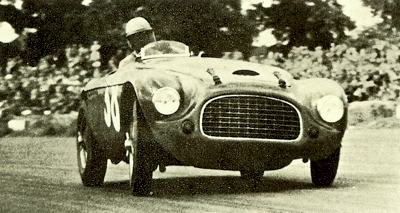 Alberto Ascari's Ferrari Sport at Silverstone in 1950.
Alberto Ascari's Ferrari Sport at Silverstone in 1950.
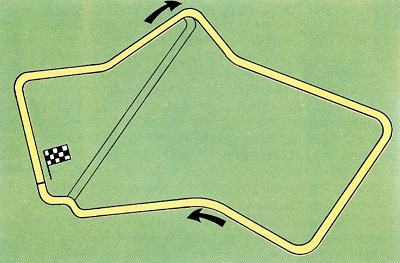 Silverstone circa 1975 - which shows why it was such a fast circuit.
Silverstone circa 1975 - which shows why it was such a fast circuit.
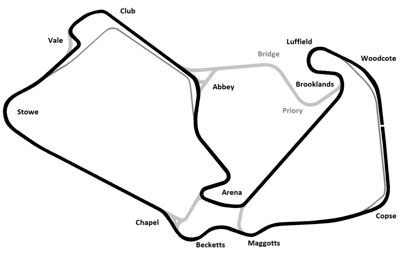 Silverstone in 2010, hardly recognisable from how it looked in 1975.
Silverstone in 2010, hardly recognisable from how it looked in 1975.
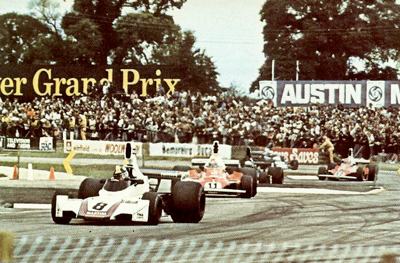 Carlos Pace's Brabham leads a stream of 1975 F1 GP cars through the Woodcote esses. This chicane was added in 1975 to reduce speeds through the almost flat-out corner, where cars entered at 165 miles per hour.
Carlos Pace's Brabham leads a stream of 1975 F1 GP cars through the Woodcote esses. This chicane was added in 1975 to reduce speeds through the almost flat-out corner, where cars entered at 165 miles per hour.
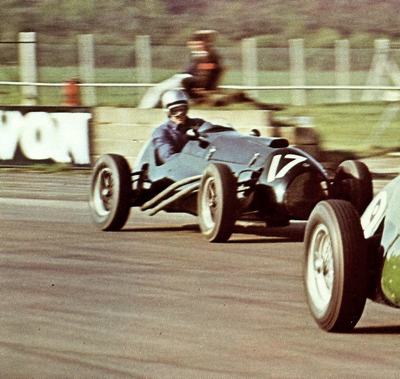 A Connaught in action at one of Silverstone's famous historic races during the 1960's.
A Connaught in action at one of Silverstone's famous historic races during the 1960's.
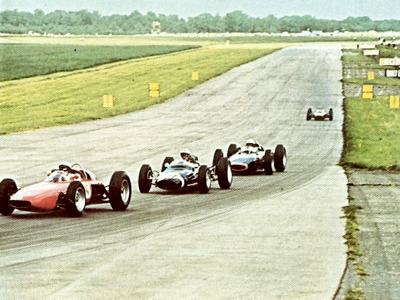 A group of mid 1960's F1 cars come off Hangar straight into Stowe.
A group of mid 1960's F1 cars come off Hangar straight into Stowe.
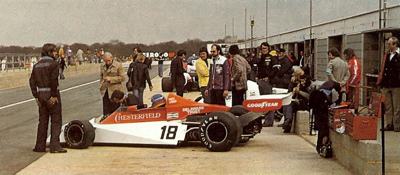 The pits area at Silverstone, circa 1974.
The pits area at Silverstone, circa 1974. |
Royal Silverstone
For 1950 Club Copse and Stowe corners were eased to reduce the lap length further to 2.86 miles and the scene was set for the 'Royal Silverstone'. HM King George VI, Queen Elizabeth and other members of the Royal Family attended the Grand Prix on 13 May. It was the first time a road race in Britain had been attended by a reigning monarch; it was also the first time Grand Prix d' Europe had been granted to a British race; and it was the first ever race anywhere to qualify for the newly-instigated World Championship of Drivers.
Alfa Romeo, making a return to racing in what turned out to be a successful attempt to win the World Championship, scored a 1-2-3 success,
Giuseppe Farina leading home Luigi Fagioli and Reg Parnell. Britain's great hope, the V16 BRM, was unready, making a parade lap only. The BRM was due to make it's race debut at the Daily Express Trophy meeting three months later but, as is embarrassingly well-recorded in motor racing history, it broke a drive-shaft on the line. Perhaps Silverstone's greatest short-coming has been its flatness and consequent poor drainage. The 1951 Daily Express Trophy had to be halted after six laps after a torrential downpour which completely flooded the track, not to mention the cockpits of the racing cars.
The 1975 John Player British Grand Prix
The problem recurred several times after, at both international and small club meetings, most notably at the 1975 John Player British Grand Prix when no fewer than ten cars crashed within seconds following a sudden downpour. The race had to be red-flagged to a stop with 56 of the scheduled 67 laps run. From 1949 the circuit became increasirigly regularly used by amateurs and semi-professionals for club meetings and in 1951 the first of a long series of six-hour relay races was held. At first a 2.4-mile layout using part perimeter road and part runway was employed, but soon a 1.608-mile affair was used.
The Club Circuit comprised the perimeter road from Woodcote to Becketts and a runway which linked them. In 1952 the RAC handed over operations of the circuit to the British Racing Drivers' Club and several improvements were made prior to the start of the season, including easier access to and from the public enclosures and protective earth banks. Grandstands which had been erected between Woodcote and Copse Corners in 1950 now overlooked a new start/finish line and pits and with a slight modification to Woodcote the lap length was increased to 2.927 miles, the official figure which remained until 1975.
The Most Difficult Corner In The World
Shortly before the 1975 John Player-sponsored British Grand Prix it was announced that a chicane would be laid-out at Woodcote corner in an attempt to reduce speeds. This was as a result of comments made by Grand Prix constructors about the safety of spectators in the grandstands. Woodcote had become a 160 mph corner and drivers considered it to be one of the most difficult in the world. However, should a car go into a spin there was a chance that its aerodynamic aids - meaning the rear wing - could have the opposite effect if the car went backwards. Instead of giving the car extra bite, it could cause it to take off. A debris fence had already been erected, but this was not considered strong enough to arrest a Grand Prix car.
The chicane reduced speeds to 120mph, adding 3
½ seconds to lap times, but Silverstone - by then 2.932 miles long - remained Britain's fastest circuit, except the lap record was now 133.93 mph instead of 135·96 mph. Lap speeds rose dramatically in the 1960s. Before the 1960 Daily Express Trophy meeting the lap record stood at 105.37mph; after the race winner
Innes Ireland (2.5-liter Lotus 18-Climax) had raised this to 111.86 mph and by the end of the decade the 120 mph barrier had been well and truly cracked and 130 mph was in easy reach. (But for the introduction of the Woodcote chicane, 140 mph laps were a possibility before the end of the 1970s.)
In the 1960s and 1970s Silverstone saw many more excitmg motor races. There was Graham Hill's determined and successful chase of
Jim Clark in the 1962 Daily Express Trophy where Hill's BRM PS6 literally pipped Clark's Lotus 24-Climax on the finish line. Ironically enough,
Jack Brabham meted out the same treatment two years later when his Brabham BT7-Climax conquered Hill's BRM P261 in similar fashion. For drama in front of a packed grandstand, little can equal the flaming multiple accident after one lap of the 1973 John Player British Grand Prix. Eight cars were eliminated in spectacular fashion, yet there was only one injury as Italian driver Andrea de Adamich left the race with leg injuries.
The face of Silverstone continually changed. Oil drums which marked the corners were replaced with low co
ncrete walls and in 1970 these, in turn, were scrapped to give way to plastic marker cones. Following two fatal accidents in 1963 the pit area was completely rebuilt for the following season, being elevated and reached via a ramp. Eleven years later these were pulled down to be replaced by one of the largest and most sophisticated pit areas in the world, reputedly costing £120,000. Over the years other modifications included a press/television tower at Woodcote, spectator and vehicles bridges, permanent buildings and a ring-road to ease spectator entrance and exit.
Resurfacing with Dunlop Delugrip
Silverstone has also kept pace with constant demands for safety improvements by drivers, including better run-on areas, catch-fencing and guard-rails. The next improvement, in 1978, was the resurfacing with Dunlop 'Delugrip', intended to provide a faster (up to two seconds a lap for the Grand Prix circuit), and safer track. Ironically, the first race on the new surface was the farcical 1978 Daily Express Trophy. The race, well won by Keke Rosberg, was run after a prolonged downpour with the track awash, resulting in many cars sailing off in spectacular fashion. While this served to show once more that Silverstone was one of the safest high-speed tracks at which to crash, it emphasised that resurfacing alone was not the answer.
Standing water still collected on the flat surface and it was felt necessary to repeat the rebuilding exercise incorporating cambering in selected areas to deal with the persistent problem of poor drainage. With the growth of post-war motor racing in Britain it was inevitable other circuits would wish to take the Grand Prix from Silverstone, The RAC gave the date to Aintree in 1955, 1957, 1959, 1961 and 1962 and from 1964 the Grand Prix has been run every two years at Brands Hatch. (In order to allow the circuits to plan well ahead, the RAC agreed the British Grand Prix should alternate between Silverstone and Brands Hatch until the end of the I970s.)
The annual Daily Express Trophy meeting had been run for Formula One cars on all but three occasions; in 1952 and 1953 it was for Formula Two and in 1961 for Inter-Continental Formula cars. The list of winners included such names as
Ascari,
Farina, Hawthorn, Gonzalez,
Moss,
Behra, Collins,
Brabham,
Clark, Stewart, Hulme, Hill, Fittipaldi, Hunt and
Lauda. From 1960 to 1974 Martini sponsored a major race at Silverstone, usually for sports cars, while GK backed Formula 5000 cars. The Tourist Trophy found a home at Silverstone in 1970 and but for 1971, when it was cancelled, has been run to its original format for production cars.
Bridge Corner
Bridge Corner was subtly rerouted in 1987 before the track underwent a major redesign between the 1990 and 1991 races, transforming the ultra-fast track (where every corner was taken in no lower than 4th or 5th gear, depending on the transmission of the car) except for the Bridge chicane, which was usually taken in 2nd gear) into a more technical track. The reshaped track's first F1 race was perhaps the most memorable of recent years, with Nigel Mansell coming home first in front of his home crowd. On his victory lap back to the pits Mansell even found time to pick up stranded rival Ayrton Senna and give him a lift on his side-pod, after Senna's McLaren had run out of fuel on the final lap of the race.
Hangar Straight to Stowe Corner
Following the deaths of Senna and fellow Grand Prix driver Roland Ratzenberger at Imola in 1994, many Grand Prix circuits were modifed in order to reduce speed and increase driver safety. As a consequence of this the entry from Hangar Straight into Stowe Corner was modified in 1995 so as to make its entry less dangerous and, as a result, less challenging, and the flat-out Abbey kink was modified to a chicane in just 19 days before the 1994 GP.
Bernie Ecclestone
Bernie Ecclestone stated that he would only negotiate the future of Formula One at Silverstone post-2009 if the BRDC gave up its role as promoter of the event. In an Autosport interview he said "I want to deal with a promoter rather than the BRDC. It is too difficult with the BRDC because you get no guarantees with them. We've said that unless they can get the circuit to the level expected from so-called third-world countries we are not prepared to do a deal. They know what we want them to build. A new pit-and-paddock complex is the minimum redevelopment required.
Maurice Hamilton described the attitude of the BRDC as "(appearing to be) inflexible and sometimes arrogant". During testing ahead of the British Grand Prix, Damon Hill likened the relationship between the BRDC and governing body as that of Aladdin's Cave: "The genie says give me the lamp and Aladdin says get me out of the cave and I’ll give you the lamp. You’re in this constant cycle whereby in order to get our plans implemented we need to have a Grand Prix contract, and in order to get the Grand Prix contract we have to have our planning."
The British MotoGP
On 1 August 2007 it was announced that a £25m redevelopment of the circuit had been approved, with new grandstands, pit facilities and a development centre planned. However, on 4 July 2008 it was announced that the event will move to Donington Park from 2010. On 12 January 2009 it was announced that Silverstone will host the British MotoGP from 2010 after signing a five year deal to hold this event. On 18 February 2009, the first pictures of the MotoGP Layout emerged (this has since changed to the layout now being constructed). The track will be slightly longer than the Grand Prix circuit, as it uses parts of the three main configurations at Silverstone – the Grand Prix circuit from the start-finish to Abbey corner, then turns right to go up part of the International layout in reverse, before joining the National Circuit's straight from a left-hand hairpin known as the Arrowhead. Having negotiated the straight, the bikes will rejoin the Grand Prix circuit at Brooklands.
On 20 June 2009 Bernie Ecclestone stated that there would be a British Grand Prix at Silverstone in 2010 if Donington was not ready to host it. When asked why he had moved from his previous "Donington or nothing" standpoint he cited changes in the structure of the BRDC meaning there was a better way of negotiating with them over future commercial rights. Furthermore during an interview with the BBC about the Formula One Teams Association threatening to break away and form their own series, FIA president Max Mosley said it was "highly likely" the 2010 British Grand Prix would return to Silverstone.
On 24 October 2009, BBC News reported that Donington had failed to raise the £135 million needed to stage a British Grand Prix and that Donington's bid 'looks over' and the F1 supremo has offered the race to Silverstone, but the terms appear to be the same as those that the Circuit rejected first time round. On 7 December 2009, Silverstone was awarded the rights to host the British Grand Prix for the next 17 years. Part of the deal is for a new pit lane to be built. On 11 February 2010, it was announced that the British Grand Prix would use the "Arena" circuit configuration, thus increasing the track's length by 759 metres.
Ahead of the 2011 Grand Prix, a new pit complex is scheduled to be completed, making the straight between Club and Abbey corners the new pit straight. On 1 March 2011 Silverstone Circuits confirmed that the Bridge section of the track had been decommissioned and would not be used again. Large scale earthworks are currently taking place to open up this area for spectators. "the old Bridge section of the circuit has been decommissioned and this has been sanctioned by the BRDC - however please note that the tarmac will still remain intact and not be removed. This decision was not taken lightly but with the development of The Silverstone Wing and the new pit lane exit, the Bridge section of the Grand Prix Circuit has been made redundant. The banked area that you have shown in your photo will open up the track at Luffield and will become a new spectator area bringing fans closer to the action."
